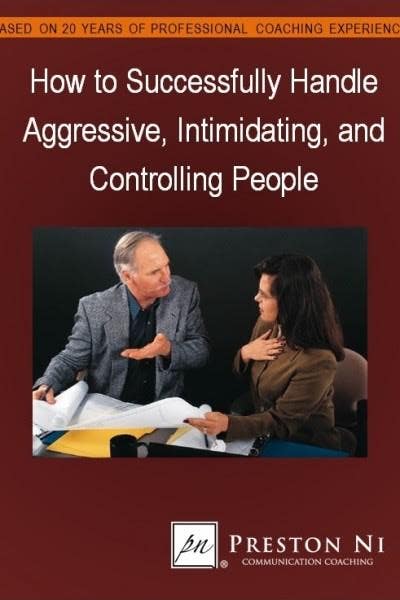The 5 Most Common Types Of Adult Bullying
Five types of bullying tactics.
 weheartit
weheartit “Some people try to be tall by cutting off the heads of others.” —Paramahansa Yogananda
The American Psychological Association defines bullying as “a form of aggressive behavior in which someone intentionally and repeatedly causes another person injury or discomfort. Bullying can take the form of physical contact, words, or more subtle actions.” A bully can be an aggressive juvenile, an intimidating boss or colleague, a controlling romantic partner, an unruly neighbor, a high-pressure sales/business representative, a condescending family member, a shaming social acquaintance, or those in a variety of other types of abusive relationships.
Here are five common tactics bullies use to extort undue influence and power, with references from my book, How to Handle Aggressive, Intimidating, and Controlling People. A bully may utilize one or more of the following methods to inflict harm while deriving wretched pleasure from the suffering of the victim.
1. Physical bullying
This refers to the use of physical intimidation, threat, harassment and/or harm. Examples of physical bullying include physical attack, simulated violence (such as raising a fist as if to strike, or throwing objects near a person), extortion, date rape, marital rape, domestic violence, sexual harassment at work, personal space violation, physical space entrapment, physical size domination, and numerical domination (ganging up on a victim).
“I had my bully, and it was excruciating. Not only the bully, but the intimidation I felt." — Robert Cormier
2. Tangible/material bullying
Using one’s formal power (i.e., title or position) or material leverage (i.e., financial, informational, or legal) as forms of intimidation, threat, harassment, and/or harm. In these scenarios, the bully uses his or her advantage in stature and/or resources to dominate and control the victim.
“The greater the power, the more dangerous the abuse.” — Edmond Burke
3. Verbal bullying
Threats; shaming; hostile teasing; insults; constant negative judgment and criticism; or racist, sexist, or homophobic language.
“The scars from mental cruelty can be as deep and long-lasting as wounds from punches or slaps but are often not as obvious.” ―Lundy Bancroft
4. Passive-aggressive or covert bullying
This is a less frequently mentioned form of bullying, but in some ways, it's the most insidious. With many bullies, you can see them coming because they are quick to make their intimidating presence known. A passive-aggressive or covert bully, however, behaves appropriately on the surface but takes you down with subtlety.
Examples of passive-aggressive and covert bullying include negative gossip, negative joking at someone’s expense, sarcasm, condescending eye contact, facial expression or gestures, mimicking to ridicule, deliberately causing embarrassment and insecurity, the invisible treatment, social exclusion, professional isolation, and deliberately sabotaging someone’s well-being, happiness, and success.
"Behind the smile, a hidden knife!" ―Ancient Chinese proverb describing passive-aggressive behavior
5. Cyber bullying
Many types of tangible, verbal, and passive-aggressive behavior mentioned above can be conveyed online via social media, texting, video, email, online discussion, and other digital formats. Identity theft is also a form of cyber bullying.
“Cyber bullies…do not need direct physical access to their victims to do unimaginable harm.” ―Anna Maria Chavez
What these five types of bullying have in common is that, when enacted repeatedly, they become patterns of physical, mental, and/or emotional abuse. Unless strong and effective boundaries are established, the bully is likely to repeat and intensify the abuse.
“Someone who hates you normally hates you for one of three reasons: They see you as a threat. They hate themselves. Or they want to be you.” ―Unknown
The most important thing to keep in mind about bullies is that they pick on those whom they perceive as weaker. So, as long as you remain passive and compliant, you make yourself a target. Many bullies are also cowards: When their victims begin to show backbone and stand up for their rights, a bully will often back down. This is true in schoolyards, as well as in domestic and office environments.
“I realized that bullying never has to do with you. It's the bully who's insecure.” —Shay Mitchell
When confronting bullies, be sure to place yourself in a position where you can safely protect yourself, whether it’s standing tall on your own, having other people present as witnesses and support, or keeping a paper trail of the bully’s inappropriate behavior. In cases of physical, verbal, or emotional abuse, consult with counseling, legal representation, law enforcement, or administrative professionals. It’s important to stand up to bullies — and you don’t have to do it alone.
.......

Preston Ni is the author of "How to Successfully Handle Aggressive, Intimidating, and Controlling People" and "How to Successfully Handle Passive-Aggressive People."
© 2017 by Preston C. Ni. All rights reserved worldwide. Copyright violation may subject the violator to legal prosecution.

